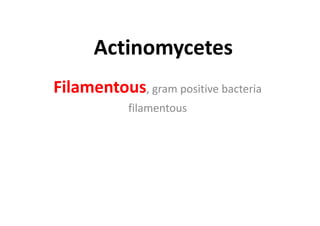
Actinomycetes
- 1. Actinomycetes Filamentous, gram positive bacteria filamentous
- 2. These are the organisms with characteristics common to both bacteria and fungi but yet possessing distinctive features to delimit them into a distinct category. In the strict taxonomic sense, actinomycetes are clubbed with bacteria the same class of Schizomycetes and confined to the order Actinomycetales. They are unicellular like bacteria, but produce a mycelium which is non-septate (coenocytic) and more slender, like true bacteria they do not have distinct cell-wall and their cell wall is without chitin and cellulose (commonly found in the cell wall of fungi). On culture media unlike slimy distinct colonies of true bacteria which grow quickly, actinomycetes colonies grow slowly, show powdery consistency and stick firmly to agar surface. They produce hyphae and conidia / sporangia like fungi. Certain actinomycetes whose hyphae undergo segmentation resemble bacteria, both morphologically and physiologically.
- 3. Actinomycetes are numerous and widely distributed in soil and are next to bacteria in abundance. They are widely distributed in the soil, compost etc. Plate count estimates give values ranging from 10^4 to 10^8 per gram of soil. They are sensitive to acidity / low PH (optimum PH range 6.5 to 8.0) and waterlogged soil conditions. The population of actinomycetes increases with depth of soil. They are heterotrophic, aerobic and mesophilic (25-30 ^c) organisms and some species are commonly present in compost and manures are thermophilic growing at 55-65° c temperature (eg. Thermoatinomycetes, Streptomyces).
- 4. In the order of abundance in soils, the common genera of actinomycetes are Streptomyces (nearly 70%), Nocardia and Micromonospora although Actinomycetes, Actinoplanes, Micromonospora and Streptosporangium are also generally encountered.
- 5. Functions / Role of actinomycetes: 1. Degrade/decompose all sorts of organic substances like cellulose, polysaccharides, protein fats, organic-acids etc. 2. Organic residues / substances added soil are first attacked by bacteria and fungi and later by actinomycetes, because they are slow in activity and growth than bacteria and fungi. 3. They decompose / degrade the more resistant and indecomposable organic substance/matter and produce a number of dark black to brown pigments which contribute to the dark colour of soil humus.
- 6. 4. They are also responsible for subsequent further decomposition of humus (resistant material) in soil. 5. They are responsible for earthy / musty odor / smell of freshly ploughed soils. 6. Many genera species and strains (eg. Streptomyces if actinomycetes produce/synthesize number of antibiotics like Streptomycin, Terramycin, Aureomycin etc. 7. One of the species of actinomycetes Streptomyces scabies causes disease "Potato scab" in potato.
- 11. Characteristics • Gram positive bacteria • Filamentous forming mycelial structure like fungi • Form spores • Egs. Streptomyces and Nocardia
- 12. Streptomyces • Over 500 sp are known • Branching seen • Growth is always at the tips of the filaments • Vegetative phase- a complex, tightly woven matrix, resulting in a compact, convoluted mycelium and subsequent colony • As the colony ages, characteristic aerial filaments called sporophore are formed • They project above the colony and give rise to spores distinct from endospores
- 19. Spore formation in Streptomyces
- 20. Morphology of spore bearing structure Monoverticillate with no spiral Monoverticillate with spiral biverticillate with no spiral biverticillate with spiral Closed spiral Open spiral straight flexous
- 22. Ecology of Streptomyces • Aquatic habitat • Primarily soil organisms(found in well-drained soils) preferably aerobic envt • Produce metabolite called geosmins responsible for earthy smell • They prefer alkaline to neutral soils • Nutritional requirement – versatile (wide variety of carbon sources such as sugars, alcohol etc.) • They produce extracellular enzymes for utilizing starch, cellulose and hemicellulose, proteins and fats even lignin, tannin or even rubber • 50 distinct carbon sources can be utilized so very important for recycling
- 23. Importance of Streptomyces • Antibiotic producers. Over 500 distinct antibiotics have been produced by streptomyces More than 60 antibiotics have been produced which an important application in human and veterinary medicine, agriculture and industry • Egs- streptomycin, neomycin, tetracycline, nystatin
- 24. Nocardia • Mycelial forms fragment to form coccoid or elongate elements • Aerial spore are occasionally produced • Sometimes they are acid-fast • Lipid content in cell and cell wall is very high • Common soil organisms, found everywhere • Obligate aerobes • Many utilize hydrocarbon
- 25. Nocardia is a genus of weakly staining Gram-positive, catalase-positive, rod-shaped bacteria. It forms partially acid-fast beaded branching filaments (acting as fungi, but being truly bacteria). It contains a total of 85 species. Some species are nonpathogenic, while others are responsible for nocardiosis. Nocardia species are found worldwide in soil rich in organic matter. In addition, they are oral microflora found in healthy gingiva, as well as periodontal pockets. Most Nocardia infections are acquired by inhalation of the bacteria or through traumatic introduction.
- 30. The most common form of human nocardial disease is a slowly progressive pneumonia, the common symptoms of which include cough, dyspnea (shortness of breath), and fever. It is common in immunocompromised persons. Every organ can be affected if a systemic spread takes place. Nocardia species are deeply involved in the process of endocarditis as one of its main pathogenic effects. In about 25–33% of people Nocardia infection takes the form of encephalitis and/or brain abscess formation. Nocardia may also cause a variety of cutaneous infections such as actinomycetoma (especially N. brasiliensis), cellulitis, and subcutaneous abscesses.
